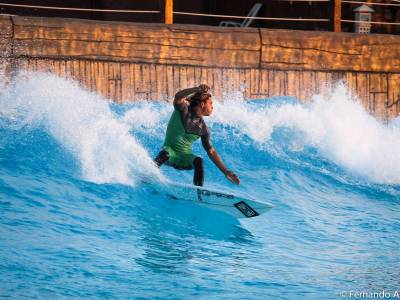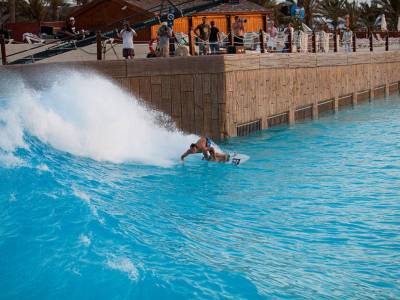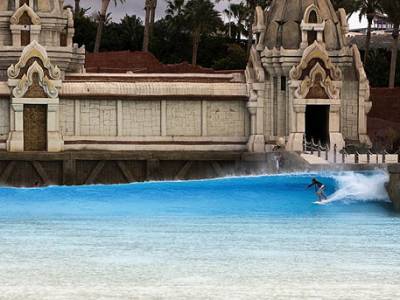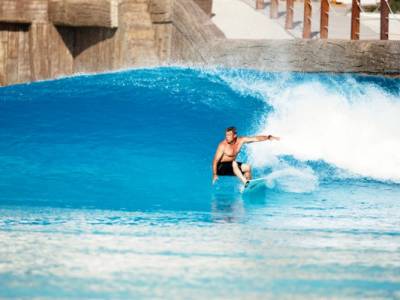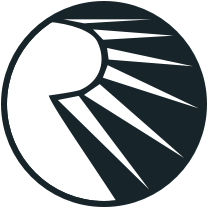Point Break Surf from Murphy's Waves
Point Break Surf Technology
The Point Break Surf technology from Murphy’s Waves creates waves by filling large tanks with water. The tanks are positioned at the back of the pool and rise above the pool water level. Gates at the bottom of each tank open in quick succession to release the water from the tanks into the wave pool, causing a surge in energy that creates a swell. That swell travels toward shallow water where it crests and breaks. The size and shape of the wave depend on the installation, the bottom contours (bathymetry) and the timing of the chamber gate opening.
Their “water drop" strategy for making surfable waves has been installed in multiple pools around the world, but its popularity spiked when their installation at Wadi Adventure opened and Electric Blue Heaven made the wave pool famous.
Wadi produces the best waves of any Point Break Surf pool and it uses five pumps to fill 10 water tanks.
Images: Murphy’s Waves
Wave Size and Shape
Murphy’s Waves identifies three variations on their Point Break Surf series and they primarily differ on wave size (and pool size).
The standard Point Break Surf wave pool will create waves up to 3.3m (11.5 feet) high measuring on the face of the wave. The Point Break Olympic Surf wave pool uses more aggressive bottom contours to create a larger wave that maxes out at 4m (13 feet). For smaller waves or smaller installation areas, Murphy’s Waves offers Point Break Surf Junior. The “junior" model can still crank out 2.4m waves according to Murphy’s Waves, which is as big as any existing surfing wave pool making waves today.
In practice, we see Point Break Surf installations like Wadi Adventure and Siam Park producing waves that range from 4 to 6′ on the face of the wave.
The shape of the waves depends on the bathymetry of the pool bottom, the size and quantity of chambers, and the operator’s settings.
As mentioned above, Murphy’s Waves claims to have a bathymetry model that can produce barrels, but barrels are almost impossible to find in any Point Break Surf installation today. The Point Break Surf wave pools in production today, like Wadi Adventure and Siam Park, are less critical, sometimes soft waves that offer the occasional vertical lip but lend themselves more to cutbacks.
The pool operator has controls that allow them to pick from an assortment of pre-programmed waves. There isn’t nearly the range of shapes and sizes offered by American Wave Machines PerfectSwell technology, but the selections typically includes some lefts, rights, A-frames and close-out air ramps that vary with speed and size.
The length of ride depends on the pool size and the wave settings. For reference, a left or right-hand wave that crosses the entire Wadi Adventure pool (which uses 10 tanks) is about 8 seconds from take off to close out.
The particle motion of the waves created by a Point Break Surf pool does not closely resemble the motion in the ocean. The waves also lack a notable trough prior to the peak. Surfers have noticed this and tend to agree that surfing the wave feels somewhat different than the ocean. However, producing waves that propagate from a “deep end" to shallow water and allow the surfer to surf toward the beach (at an angle) does resemble surfing in the ocean.
Point Break Surf pools do not focus on wave reformation to create secondary breaks off of each swell, but there is of course the inside whitewater waves for beginners.
Read More
Capacity and Productivity
Point Break Surf pools by Murphy’s waves struggle in the capacity department. The water drop strategy creates a lot of turbulence that requires time to settle and filling the tanks requires pumping a lot of water.
Murphy’s Waves says that their Point Break Surf technology can create large waves (up to 4m) every 60 seconds.
In practice, the amount of time between waves depends on a few factors, like wave size and pump volume, but pools using Point Break Surf technology today, like Typhoon Lagoon, create a wave roughly every 90 seconds, which equates to 40 waves an hour. In the case of Typhoon Lagoon, this limit is likely due the age of the installation: Typhoon Lagoon was an earlier generation of their Point Break Surf technology and its “overflow" design requires longer to fill.
Depending on the operator’s revenue strategy, the limited wave frequency could mean the number of waves a surfer gets in an hour is critically limited. Subsequently, operators can’t rely on Point Break Surf wave pools (alone) to make money. According to Murphy’s Waves, most of their Point Break installations put 10 surfers in every one hour session. Wadi Adventure puts a maximum of 6 surfers in each one-hour session, and each surfer typically gets 6 waves total during that hour. They don’t make money off the wave pool alone; they have additional activities that bring in the profit.
As mentioned above, pump speed/capacity is a key driver in wave frequency, and a representative from Murphy’s Waves said their pump supplier can provide pumps that make a 3m wave possible every 20 seconds. At that rate they are making 180 waves every hour and settling time becomes more of a concern. We won’t know the exact implications of this wave frequency until we see it in action.
The Wave Pool
Point Break Surf pools vary in size to accomodate customers’ requirements. Typhoon Lagoon and Wadi Adventure are both roughly 2.5 acres.
With a max depth of 2.4m, the volume of water in each of these pools is around 2.4 million gallons.
Controlling Point Break Surf Pools
Point Break Surf pools are controlled by the operator who uses software to determine which waves to create for customers. Wave size and shape configurations are saved into the software, then the operator picks from these configurations to determine which waves to generate for customers.
Energy Consumption
The standard Point Break Surf installation, which produces waves up to 3.3m, uses 500kw to produce waves.
Wave Pools Powered by Point Break Surf Technology
Highlights and Lowlights
| Proven technology used for years. |
| Wave production rate is very low. | |
| Limited wave shapes. | |
| Relatively low power wave. | |
| No quality secondary waves for beginners. |

